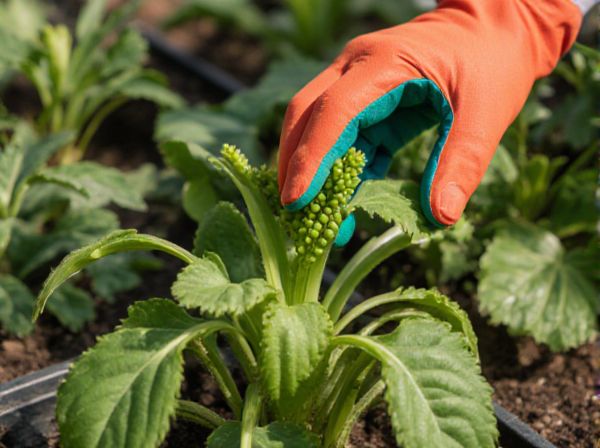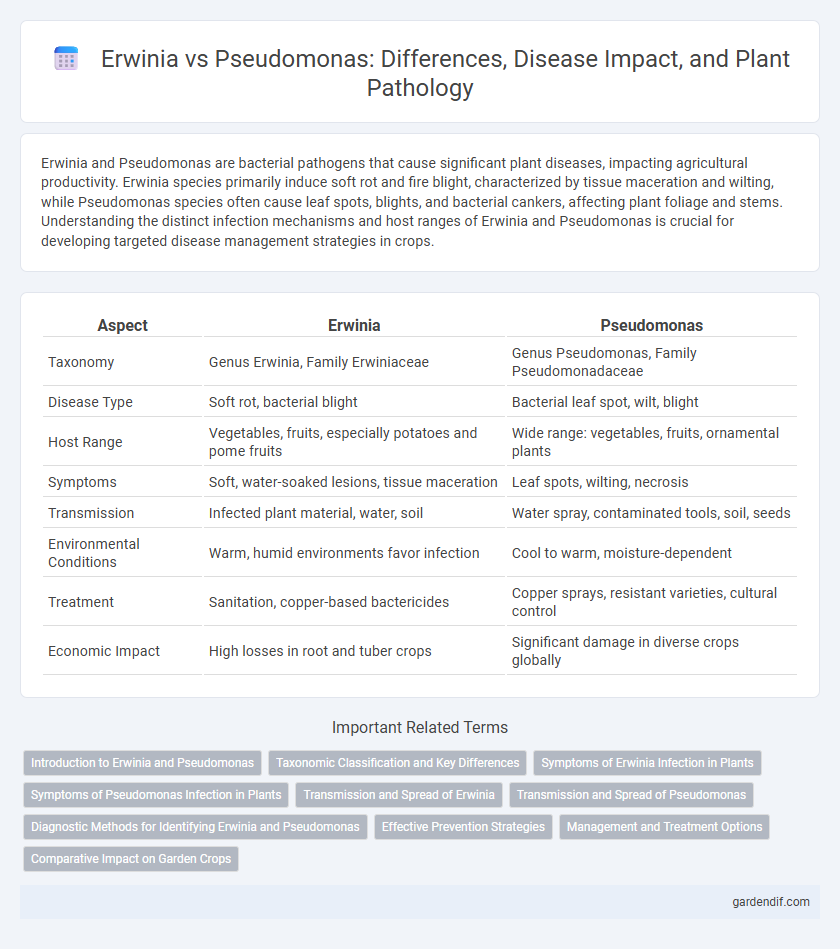
Erwinia vs Pseudomonas Illustration
Erwinia and Pseudomonas are bacterial pathogens that cause significant plant diseases, impacting agricultural productivity. Erwinia species primarily induce soft rot and fire blight, characterized by tissue maceration and wilting, while Pseudomonas species often cause leaf spots, blights, and bacterial cankers, affecting plant foliage and stems. Understanding the distinct infection mechanisms and host ranges of Erwinia and Pseudomonas is crucial for developing targeted disease management strategies in crops.
Table of Comparison
| Aspect | Erwinia | Pseudomonas |
|---|---|---|
| Taxonomy | Genus Erwinia, Family Erwiniaceae | Genus Pseudomonas, Family Pseudomonadaceae |
| Disease Type | Soft rot, bacterial blight | Bacterial leaf spot, wilt, blight |
| Host Range | Vegetables, fruits, especially potatoes and pome fruits | Wide range: vegetables, fruits, ornamental plants |
| Symptoms | Soft, water-soaked lesions, tissue maceration | Leaf spots, wilting, necrosis |
| Transmission | Infected plant material, water, soil | Water spray, contaminated tools, soil, seeds |
| Environmental Conditions | Warm, humid environments favor infection | Cool to warm, moisture-dependent |
| Treatment | Sanitation, copper-based bactericides | Copper sprays, resistant varieties, cultural control |
| Economic Impact | High losses in root and tuber crops | Significant damage in diverse crops globally |
Introduction to Erwinia and Pseudomonas
Erwinia and Pseudomonas are genera of gram-negative bacteria associated with plant diseases causing significant agricultural losses. Erwinia species are primarily known for bacterial soft rot and fire blight affecting fruits and vegetables, producing enzymes that degrade plant cell walls. Pseudomonas species, such as Pseudomonas syringae, cause leaf spots and blights, deploying diverse virulence factors that disrupt plant immune responses and promote infection.
Taxonomic Classification and Key Differences
Erwinia and Pseudomonas are both Gram-negative bacterial genera within the class Gammaproteobacteria but belong to different families; Erwinia is classified under the family Erwiniaceae, while Pseudomonas is part of the family Pseudomonadaceae. Erwinia species are predominantly plant pathogens causing soft rot and fire blight diseases, characterized by pectolytic enzyme production, whereas Pseudomonas species exhibit diverse lifestyles, including plant pathogenicity and biocontrol, with notable species like Pseudomonas aeruginosa known for opportunistic human infections. The key taxonomic distinction lies in their phylogenetic lineage and ecological roles, with Erwinia showing a more narrow host specificity compared to the metabolically versatile Pseudomonas.
Symptoms of Erwinia Infection in Plants
Erwinia infection in plants primarily causes soft rot characterized by water-soaked, mushy lesions that rapidly expand and emit a foul odor due to tissue decay. Symptoms also include wilting, leaf yellowing, and stem cankers with gummy exudates that disrupt vascular function. Unlike Pseudomonas infections, Erwinia's progression leads to extensive tissue maceration and collapse, severely impacting crop yield and quality.
Symptoms of Pseudomonas Infection in Plants
Pseudomonas infection in plants typically causes water-soaked lesions that rapidly enlarge and turn necrotic, often surrounded by chlorotic halos. Infected leaves may exhibit a greasy or oily appearance, while stem and fruit infections result in soft rot and wilting symptoms. The bacterial exudate can create a slimy texture on affected tissues, facilitating disease spread under humid conditions.
Transmission and Spread of Erwinia
Erwinia bacteria primarily spread through rain splash, insects, and mechanical damage on plants, facilitating rapid infection in crops like apples and potatoes. The pathogen's transmission is enhanced by wounds created during handling or pruning, allowing entry into plant tissues where it multiplies and causes rot. Effective control requires managing insect vectors and minimizing plant injuries to reduce Erwinia dissemination.
Transmission and Spread of Pseudomonas
Pseudomonas transmits primarily through contaminated water, soil, and plant debris, facilitating widespread dispersal in agricultural environments. Its ability to survive in diverse conditions allows rapid colonization of plant surfaces and internal tissues, enhancing infection rates. In contrast, Erwinia spreads mainly via infected seeds, pruning tools, and insect vectors, resulting in more localized transmission patterns.
Diagnostic Methods for Identifying Erwinia and Pseudomonas
Diagnostic methods for identifying Erwinia and Pseudomonas primarily involve culture-based techniques on selective media, biochemical tests, and molecular assays such as PCR targeting species-specific genes. Erwinia species can be distinguished by their ability to produce characteristic pectolytic enzymes leading to soft rot symptoms, while Pseudomonas species are detected by their production of fluorescent pigments under UV light on King's B medium. Advanced identification employs 16S rRNA gene sequencing and MALDI-TOF mass spectrometry for precise differentiation between these two phytopathogenic bacterial genera.
Effective Prevention Strategies
Effective prevention strategies for Erwinia infections emphasize sanitation, crop rotation, and the removal of infected plant material to reduce bacterial reservoirs. In contrast, managing Pseudomonas diseases requires the use of resistant plant varieties, copper-based bactericides, and proper irrigation practices to minimize leaf wetness and bacterial spread. Both pathogens benefit from integrated disease management approaches that combine cultural practices and chemical controls to limit outbreaks in agricultural settings.
Management and Treatment Options
Effective management of Erwinia infections primarily involves the use of copper-based bactericides and strict sanitation practices to prevent bacterial spread in crops. Treatment options for Pseudomonas diseases often include the application of antibiotics like streptomycin and plant resistance inducers, coupled with crop rotation and removal of infected plant material. Both bacterial pathogens require integrated disease management strategies combining chemical, cultural, and biological controls to reduce impact and improve crop health.
Comparative Impact on Garden Crops
Erwinia species primarily cause soft rot and bacterial blight in garden crops such as tomatoes, potatoes, and cucumbers, leading to tissue maceration and significant yield loss. Pseudomonas species, especially Pseudomonas syringae, induce bacterial speck, leaf spot, and blights on crops including beans, peppers, and lettuce, often reducing crop quality and marketability. The comparative impact reveals Erwinia's aggressive rotting effect contrasts with Pseudomonas's role in foliar disease, both demanding targeted management to minimize economic damage in diverse garden vegetables.
Erwinia vs Pseudomonas Infographic

 gardendif.com
gardendif.com